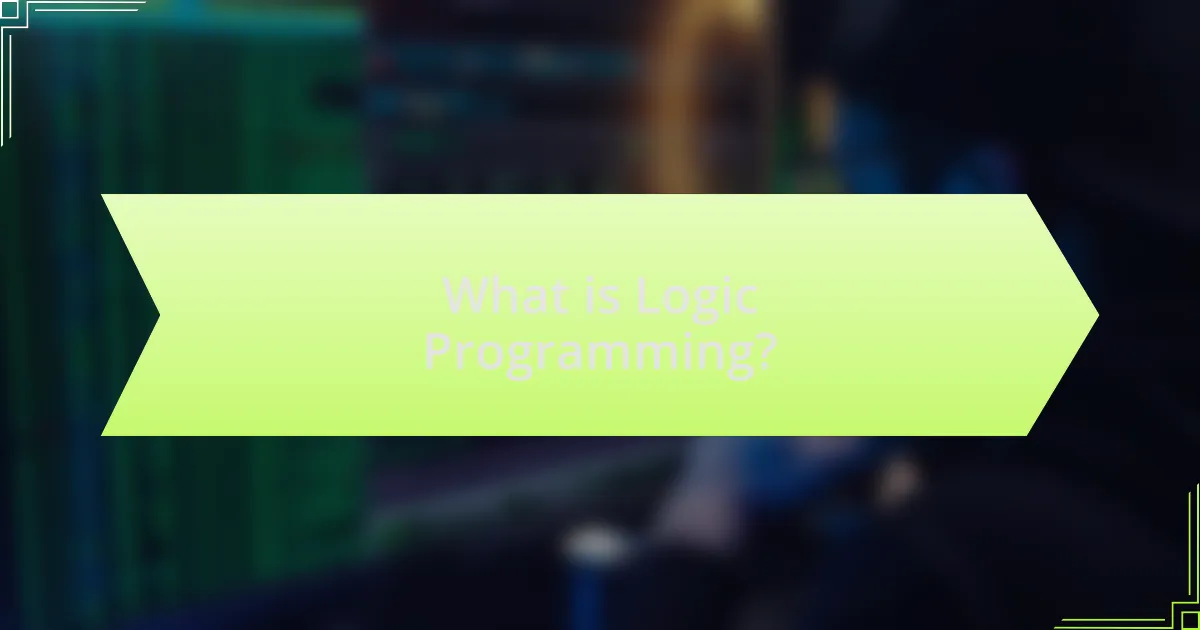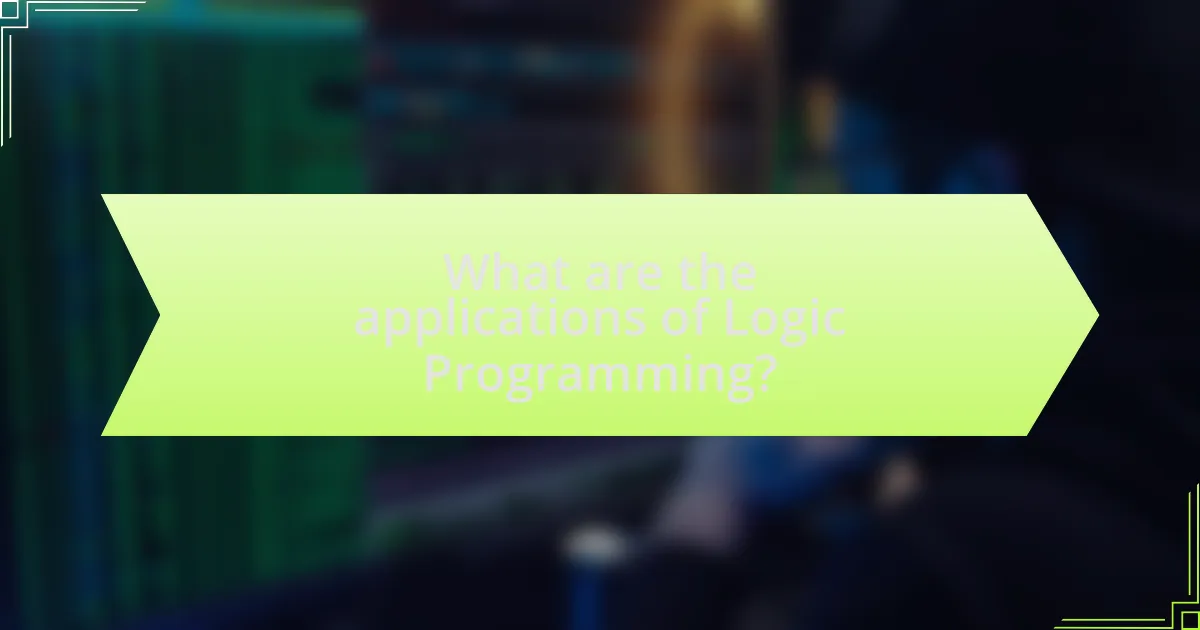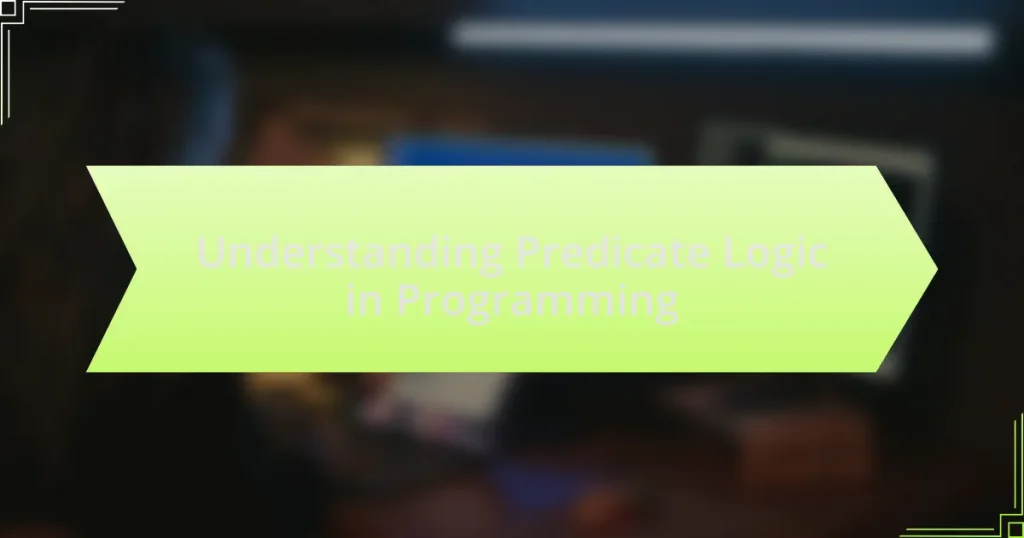Logic programming is a programming paradigm grounded in formal logic, where program statements articulate facts and rules about specific problem domains. This article provides a comprehensive overview of logic programming, detailing its fundamental principles, historical developments, and key components such as facts, rules, and queries. It explores the differences between logic programming and other paradigms, the inference techniques employed, and the applications of logic programming in fields like artificial intelligence and database management. Additionally, the article addresses the advantages and limitations of this paradigm, offering best practices for effective implementation and optimization strategies for developers.

What is Logic Programming?
Logic programming is a programming paradigm based on formal logic, where program statements express facts and rules about some problem domain. In this paradigm, computation is performed through the process of logical inference, allowing the programmer to specify what the program should accomplish rather than how to achieve it. This approach is exemplified by languages such as Prolog, which utilizes a set of logical clauses to derive conclusions from given facts. Logic programming is validated by its application in artificial intelligence and computational linguistics, where it effectively handles complex problem-solving tasks through logical reasoning.
How does Logic Programming differ from other programming paradigms?
Logic programming differs from other programming paradigms primarily in its approach to problem-solving, which is based on formal logic rather than procedural or object-oriented methods. In logic programming, programs are expressed as a set of facts and rules within a logical framework, allowing the system to infer conclusions through automated reasoning. This contrasts with imperative programming, where the focus is on explicitly defining a sequence of commands to achieve a desired outcome, and with object-oriented programming, which emphasizes encapsulation and the manipulation of objects. The foundational logic programming languages, such as Prolog, utilize a declarative style, enabling programmers to specify what the program should accomplish without detailing how to achieve it, thus facilitating a different paradigm of thinking about computation.
What are the key principles of Logic Programming?
The key principles of Logic Programming include the use of formal logic as a programming paradigm, where programs are expressed in terms of relations and rules. Logic Programming relies on facts and rules to derive conclusions through a process called resolution. This paradigm emphasizes declarative programming, meaning that the focus is on what the program should accomplish rather than how to achieve it. Additionally, it utilizes a process of unification to match terms and variables, enabling the inference of new information from existing knowledge. These principles are foundational in languages such as Prolog, which exemplifies the application of Logic Programming in solving complex problems through logical reasoning.
How does declarative nature influence Logic Programming?
The declarative nature of Logic Programming allows programmers to specify what the program should accomplish without detailing how to achieve those results. This abstraction simplifies the programming process, enabling developers to focus on the logic of the problem rather than the control flow. For instance, in languages like Prolog, users define relationships and rules, and the underlying engine determines the execution strategy to derive conclusions. This approach enhances readability and maintainability of code, as it aligns closely with human reasoning and problem-solving methods, making it easier to express complex ideas succinctly.
What are the historical developments of Logic Programming?
Logic programming has evolved significantly since its inception in the 1960s, primarily through the development of key languages and theoretical frameworks. The first major milestone was the creation of Prolog in 1972, which introduced a declarative programming paradigm based on formal logic. This was followed by the introduction of the resolution principle by John Alan Robinson in 1965, which provided a foundation for automated theorem proving and logic programming. In the 1980s, the integration of logic programming with functional programming led to the development of languages like Mercury and Oz, enhancing expressiveness and efficiency. The advancements in artificial intelligence during the 1990s further propelled logic programming, particularly in areas such as natural language processing and knowledge representation. These historical developments underscore the transition from theoretical concepts to practical applications, establishing logic programming as a vital area in computer science.
Who were the pioneers in Logic Programming?
The pioneers in Logic Programming include John McCarthy, who developed the Lisp programming language, and Alan Robinson, known for his work on resolution and theorem proving. Their contributions laid the foundation for the field, with McCarthy’s work in artificial intelligence and Robinson’s development of the resolution principle being critical milestones. These advancements established the theoretical underpinnings of Logic Programming, influencing subsequent languages like Prolog, which emerged in the early 1970s.
What milestones have shaped the evolution of Logic Programming?
The evolution of Logic Programming has been shaped by several key milestones, including the development of Prolog in the early 1970s, which introduced a practical implementation of logic-based programming. This was followed by the introduction of the resolution principle by John Robinson in 1965, which provided a foundational method for automated theorem proving. Additionally, the publication of “The Art of Prolog” by Leon Sterling and Ehud Shapiro in 1986 further solidified Prolog’s role in the field. The emergence of constraint logic programming in the late 1980s expanded the capabilities of Logic Programming by integrating constraints into the logic framework. These milestones collectively contributed to the establishment and advancement of Logic Programming as a significant paradigm in computer science.

What are the fundamental concepts in Logic Programming?
The fundamental concepts in Logic Programming include facts, rules, and queries. Facts represent basic assertions about the world, such as “Socrates is a man.” Rules define relationships and conditions, typically in the form of implications, such as “If X is a man, then X is mortal.” Queries are questions posed to the logic program to retrieve information based on the defined facts and rules, like asking “Is Socrates mortal?” These concepts are foundational as they enable the representation of knowledge and reasoning in a formal, declarative manner, allowing for automated inference and problem-solving.
What are the main components of Logic Programming languages?
The main components of Logic Programming languages are facts, rules, and queries. Facts represent basic assertions about the world, rules define relationships between facts and allow for inference, and queries are used to retrieve information based on the facts and rules defined. For example, in Prolog, a well-known Logic Programming language, a fact might state “socrates is a man,” while a rule could express “all men are mortal.” This structure enables the logical reasoning process fundamental to Logic Programming.
How do facts and rules function in Logic Programming?
Facts and rules in Logic Programming serve as the foundational components for knowledge representation and inference. Facts represent basic assertions about the world, such as “Birds can fly,” while rules define relationships and logical implications, such as “If X is a bird, then X can fly.” These elements work together in a declarative manner, allowing the programmer to specify what is true and how to derive new truths from existing knowledge. The validity of this structure is evidenced by the operational semantics of Logic Programming languages like Prolog, where the inference engine uses facts and rules to derive conclusions through a process called resolution.
What role do queries play in Logic Programming?
Queries in Logic Programming serve as a mechanism for retrieving information and verifying conditions based on the rules and facts defined within a program. They allow users to pose questions to the logic system, which then evaluates the queries against its knowledge base to produce answers or determine the truth of propositions. This functionality is essential for problem-solving and reasoning, as it enables the exploration of relationships and the extraction of conclusions from the established logical framework. The effectiveness of queries in Logic Programming is evidenced by their use in various applications, such as database systems and artificial intelligence, where they facilitate complex decision-making processes.
How is inference achieved in Logic Programming?
Inference in Logic Programming is achieved through a process called resolution, which involves deriving new facts from existing knowledge using logical rules. This process utilizes a set of premises and a goal, applying inference rules such as modus ponens and unification to deduce conclusions. The resolution method systematically refines the search for solutions by eliminating contradictions and confirming the validity of derived statements, ensuring that the conclusions drawn are logically consistent with the initial set of facts.
What are the different inference techniques used?
The different inference techniques used in logic programming include forward chaining, backward chaining, resolution, and unification. Forward chaining is a data-driven approach that applies rules to known facts to derive new facts until a goal is reached. Backward chaining, on the other hand, is a goal-driven method that starts with a goal and works backward to determine which facts must be true to support that goal. Resolution is a rule of inference used primarily in automated theorem proving, where contradictions are derived to prove the validity of a statement. Unification is a process that makes two logical expressions identical by finding a substitution for their variables. These techniques are foundational in logic programming and are widely utilized in artificial intelligence and automated reasoning systems.
How does backtracking work in Logic Programming?
Backtracking in logic programming is a systematic method for exploring possible solutions to a problem by incrementally building candidates and abandoning those that fail to satisfy the constraints of the problem. This approach allows the logic programming system to search through the solution space efficiently by reverting to previous states when a dead end is encountered, thus enabling the exploration of alternative paths.
For instance, in Prolog, backtracking occurs automatically when a predicate fails; the system reverts to the last successful predicate and attempts the next possible option. This mechanism is crucial for solving problems like puzzles or constraint satisfaction, where multiple solutions may exist, and it ensures that all potential solutions are explored without redundant computations.

What are the applications of Logic Programming?
Logic programming has diverse applications across various fields, including artificial intelligence, natural language processing, and database management. In artificial intelligence, logic programming is utilized for knowledge representation and reasoning, enabling systems to infer new information from existing data. In natural language processing, it aids in parsing and understanding human languages through formal grammar representations. Additionally, in database management, logic programming facilitates query processing and data retrieval, allowing for efficient handling of complex queries. These applications demonstrate the versatility and effectiveness of logic programming in solving real-world problems.
In which domains is Logic Programming commonly used?
Logic Programming is commonly used in domains such as artificial intelligence, natural language processing, database systems, and automated theorem proving. In artificial intelligence, it facilitates knowledge representation and reasoning, enabling systems to infer new information from existing data. In natural language processing, Logic Programming aids in understanding and generating human language through formal semantics. Database systems utilize Logic Programming for query optimization and data retrieval, while automated theorem proving leverages its capabilities to verify mathematical theorems and logical statements efficiently. These applications demonstrate the versatility and effectiveness of Logic Programming across various fields.
How does Logic Programming contribute to artificial intelligence?
Logic programming contributes to artificial intelligence by providing a formal framework for knowledge representation and automated reasoning. This paradigm allows AI systems to express facts and rules about a domain in a declarative manner, enabling them to infer new information through logical deduction. For instance, Prolog, a prominent logic programming language, facilitates the development of expert systems that can solve complex problems by applying logical rules to a set of known facts. The effectiveness of logic programming in AI is evidenced by its application in various domains, such as natural language processing, where it helps in parsing and understanding human language through structured representations.
What role does Logic Programming play in database systems?
Logic programming plays a crucial role in database systems by enabling declarative querying and reasoning about data. It allows users to express queries in a logical form, which the database system can then interpret and execute, facilitating complex data retrieval and manipulation. For instance, languages like Prolog utilize logic programming principles to enable users to define relationships and rules, making it easier to derive new information from existing data. This approach enhances the expressiveness and flexibility of database interactions, as seen in systems that support deductive databases, where logic programming is used to infer new facts from known data.
What are the advantages and limitations of Logic Programming?
Logic programming offers several advantages, including declarative problem-solving, which allows programmers to focus on what the program should accomplish rather than how to achieve it. This leads to more concise and readable code. Additionally, logic programming supports automatic backtracking and unification, enabling efficient search and inference mechanisms. However, limitations exist, such as performance issues in large-scale applications due to the overhead of the inference engine and difficulties in expressing certain algorithms that are more naturally suited to imperative programming paradigms. Furthermore, the learning curve can be steep for those unfamiliar with the logic programming paradigm, which may hinder its adoption in some contexts.
What benefits does Logic Programming offer to developers?
Logic programming offers developers benefits such as declarative problem-solving, enhanced code maintainability, and efficient handling of complex data relationships. By allowing developers to specify what the program should accomplish rather than how to achieve it, logic programming simplifies the coding process and reduces the likelihood of errors. Additionally, languages like Prolog enable concise representation of knowledge and relationships, which can lead to more readable and maintainable code. The ability to automatically infer conclusions from given facts and rules also streamlines the development of applications that require reasoning, such as artificial intelligence and expert systems.
What challenges do programmers face when using Logic Programming?
Programmers face several challenges when using Logic Programming, including difficulty in understanding non-procedural paradigms, performance issues, and limited debugging tools. The non-procedural nature of Logic Programming can make it challenging for programmers accustomed to imperative programming languages, as they must think in terms of logical relations rather than step-by-step instructions. Performance issues arise because Logic Programming can be less efficient for certain tasks, particularly those requiring extensive computation or large datasets, as seen in benchmarks comparing Prolog with procedural languages. Additionally, the availability of debugging tools is often limited, making it harder for programmers to trace errors and optimize their code effectively.
What are some best practices for using Logic Programming effectively?
To use Logic Programming effectively, one should focus on clear problem formulation, efficient use of predicates, and leveraging built-in search strategies. Clear problem formulation involves defining the problem in terms of logical relations and constraints, which helps in creating a precise model. Efficient use of predicates ensures that the logic program remains concise and avoids redundancy, enhancing readability and maintainability. Leveraging built-in search strategies, such as backtracking and constraint satisfaction, allows for optimized query resolution and improved performance. These practices are supported by the fact that well-structured logic programs can significantly reduce computational complexity and improve execution time, as evidenced by studies in computational logic efficiency.
How can developers optimize their Logic Programming code?
Developers can optimize their Logic Programming code by employing techniques such as efficient predicate design, minimizing backtracking, and utilizing indexing. Efficient predicate design involves structuring predicates to reduce complexity and improve clarity, which can lead to faster execution. Minimizing backtracking can be achieved by using cuts (the ‘!’ operator in Prolog) to limit unnecessary search paths, thus enhancing performance. Additionally, utilizing indexing allows the logic programming system to quickly locate relevant facts, significantly speeding up query resolution. These optimization strategies are supported by empirical studies showing that well-structured logic programs can execute several times faster than poorly designed ones, demonstrating the importance of optimization in logic programming.
What common pitfalls should be avoided in Logic Programming?
Common pitfalls to avoid in Logic Programming include misunderstanding the declarative nature of the paradigm, neglecting to properly manage recursion, and failing to account for the importance of variable scoping. Misunderstanding the declarative nature can lead to treating logic programming like imperative programming, which can result in inefficient code. Neglecting recursion management can cause stack overflow errors or infinite loops, as recursion is a fundamental aspect of logic programming. Lastly, failing to manage variable scoping can lead to unintended variable shadowing or conflicts, which can produce incorrect results. These pitfalls can significantly hinder the effectiveness and reliability of logic programming solutions.



